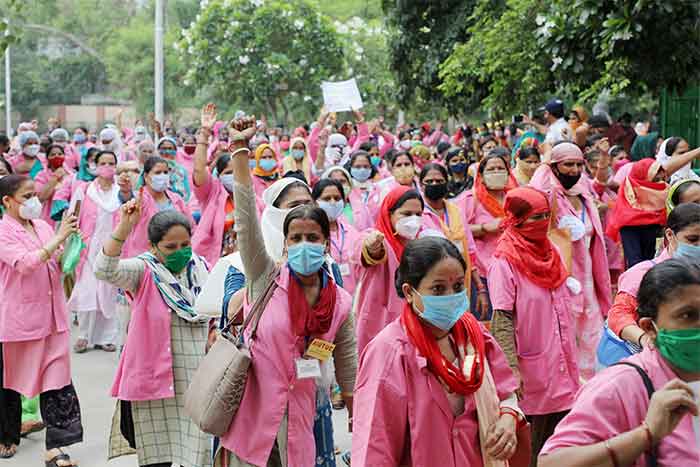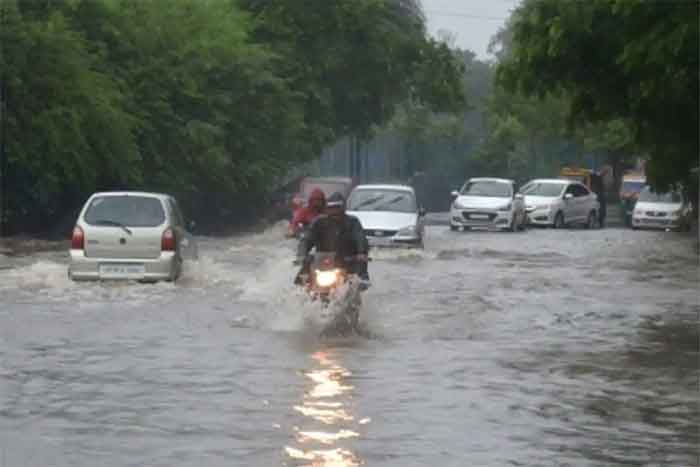
[In Part One of this article, we examined the restrictions in extending Rs.50 lakh compensation to the next of kin of Covid-19 frontline warriors who died after contracting Covid-19 while on duty. In this second and concluding part, we will try to summarize the first-person accounts of some women health workers—mainly nurses and ASHA workers—on the extreme exploitative working conditions they had to endure while waging the war against Covid-19]
Private Hospital Nurses Woefully Underpaid
The pay-scale for a Central Government Health Service nurse begins at Rs.46,000 per month. Nurses in many private hospitals and nursing homes are paid an average of Rs.7000—8000. Only some experienced nurses in some hospitals earn Rs.10,000—12,000. This despite the government fixing the salary for private sector nurses at Rs.20,000.
The Trained Nurses Association of India, which represents over three lakh private sector nurses, moved the Supreme Court in 2011 on the highly exploitative conditions prevailing in the private hospitals. After hearing the plight of the private sector nurses for nearly five long years, on 29 January 2016, the apex court directed the Union Health Ministry to set up a committee to look into the working conditions of nurses in the private sector. The Ministry was thus forced to appoint a committee under Dr.Jagdish Prasad, the then Director General of Health Services. After enquiring about the condition of private hospital nurses in several States, the committee came up with a report with a scathing observation that the working conditions and pay of nurses in private hospitals were really pathetic. It found that “adequate salary and basic facilities are not provided to nurses in private hospitals and nursing homes”
 The Supreme Court then directed the government to pass appropriate laws to legally enable the workers to better pay and working conditions. The Centre in turn directed the States and Union Territories to frame laws to ensure that the earnings and working conditions of private sector nurses are at par with those of the nurses working in government hospitals.
The Supreme Court then directed the government to pass appropriate laws to legally enable the workers to better pay and working conditions. The Centre in turn directed the States and Union Territories to frame laws to ensure that the earnings and working conditions of private sector nurses are at par with those of the nurses working in government hospitals.
On 20 September 2016, the Union Health Ministry wrote to all chief secretaries of States that the wage differential between nurses working in government hospitals and private hospitals with more than 100 beds should not be more than 10% and in those hospitals and nursing homes with less than 100 beds not more than 25%.
However, even today, a private nurse earns less than half of the government hospital nurse’s wage in many hospitals – Rs.10,200 in the Fortis Hospitals chain, Rs.22,635 in Apollo Hospitals, and Rs.19,486 in Max Hospital. This is what the might of the law and the government’s enforcement will power could achieve!
After a time-lag, following the onset of the pandemic, private hospitals were also allowed to treat Covid-19 patients. They charged in the range of Rs.15,000 to Rs.20,000 per day for treatment in ICU with ventilator and oxygen facilities. But such fleecing did not make any difference to the earnings of nurses and they did not get any additional benefit for taking on an additional workload.
Box One: Supreme Court Slammed the Government and Saluted the Health Workers
[From the 30 April 2021 order by the Supreme Court hearing suo moto the case on Covid-19 relief measures by the government.]
“Healthcare personnel are at an obvious heightened risk of contracting the COVID-19 virus. However, we are aware of reports that indicate that infected healthcare personnel are left to fend for themselves without adequate availability of beds, oxygen or essential drugs. Further, some of them have also often been asked to report back to duty within 10 days of first testing positive for COVID-19 (provided they are asymptomatic), even though a longer recuperation period is often recommended.
The Central Government should, we feel examine and ensure that in addition to the schemes it has framed, other facilities such as availability of food, resting facilities during intervals between work, transportation facilities, non-deduction of salary or leave account, if afflicted by COVID 2019 or related infection, overtime allowance, in both public and private hospitals, and a separate helpline for doctors, and healthcare professionals, in cases of COVID 2019 related emergencies, is provided. All these, we feel, would show these professionals that we do not show our appreciation in mere words, but also care for them. The issues mentioned above are only symptomatic of the other broader issues that are being faced by healthcare professionals, who are instrumental in combating the pandemic. … Hence, we hope their welfare is considered seriously by the Central and State Governments. Further, we would wish to use this order to place on record our sincerest appreciation for all the public healthcare professionals – not just limited to the doctors, but also nurses, hospital staff, ambulance drivers, sanitation workers, and crematorium workers. It is through their dedicated efforts that the effect of COVID-19 pandemic is being tackled in India.
(END OF BOX)
Extra Load on Already Overburdened ASHAs
ASHA workers are perhaps the most exploited health workers in India. A National Health Mission report brought out in September 2019 said there were 10,47,324 ASHA workers in the country. Who are ASHAs? What work are they supposed to do? Let us answer the second question first.
ASHAs are supposed to create awareness in the assigned community on nutrition, basic sanitation, hygiene, and healthy living and working conditions. They will have to impart information to the local community on existing health services and ensure timely use of these services.
The ASHA worker has to counsel women and families on birth preparedness, safe delivery, importance of breast-feeding and complementary feeding, immunization, contraception, and prevention of common infection as well as on properly caring for the child.
She has to ensure that the people avail immunization, ante- and post-natal check-ups, ICDS, and sanitation services provided by the government like construction of toilets within the household. She has to escort pregnant women to the nearest government health centre, and she also has to act like a de facto ‘barefoot doctor’ and provide community level curative care for minor ailments such as diarrhea and fevers, and she has to perform care work for the elderly and the newborn. She also has to conduct surveys from time to time. In general, she would be in-charge of health monitoring and report to higher authorities any unusual outbreak of diseases.
For doing all these, how much would she be paid? ASHAs are not considered workers but “volunteers.” The fixed amount of “honorarium” she gets varies from State to State. Till 2021, an ASHA worker in Rajasthan used to be paid Rs.2970 per month, Rs.4000 in Karnataka, Rs.3000 in Tamil Nadu, Rs.10,000 in Andhra Pradesh, Rs.4500 in West Bengal and Rs.6500 in Maharashtra. Apart from this fixed component, they also get “incentives” for specific activities like Rs.300 for antenatal care, Rs.300 for arranging one institutional delivery, for 6 post-natal house visits Rs.250, for making nutrition promotion visits Rs.250, for recording birth weights Rs.50 every 3 months, Rs.100 for full immunization of a child, Rs.300 for arranging tubectomy for a woman and Rs.400 for a vasectomy, and Rs.150 for escorting a beneficiary to a government health centre and so on. On an average, an ASHA worker could earn around Rs.10,000, including the fixed allowance and incentives.
But she is not given any subsidized means of transportation like a Scooty, no priority in housing, and no special arrangement for her security. Rain or hot sun, day or night, she has to move alone through the remote villages. They have been demanding permanent employment for a long time but in vain.
Entrusted with Covid-19 Work for a Meagre Incentive of Rs.1000 per Month
In addition to their regular work, the ASHA workers were also directed to do Covid-19-related work for a meager allowance of Rs.1000 per month. For this, they would have to visit more than 5000 households for Covid-19 symptoms, take people with symptoms for Covid-19 testing, and help in arranging quarantining and do contact-tracing in confirmed cases. Finally, they would have to trace unvaccinated people and persuade them to get vaccinated and bring them to the vaccination centres. Can someone do all this at a wage of Rs.33 per day? Not only did the officials lack empathy, they seem to be ignorant of practical life in rural realities. For Rs.33 she can at best hire transportation for a single visit but to cover her targets she has to make at least 15 to 20 visits a day. But for the community support and the generous tips they are offered by the beneficiaries, the ASHA workers cannot sustain their lives and work.
But beyond Rs.1000 per month they hardly got anything else from the government—no PPE kits, not even masks and gloves or sanitisers. Many ASHA workers fell victim to Covid-19 during the second wave because the virus then had become more virulent. 150 ASHAs had died in Andhra Pradesh alone. Not only did they contract Covid-19, they also transmitted it to their partners and other family members.
Says Nirmala, an Asha worker from Phulpur, Prayagraj, “If we fall victim to Covid-19, we don’t get proper medication and treatment in the PHCs or district hospitals. We are only given paracetamol tablets and asked to stay home. In the end, we have to spend from our own pockets. Also, if one of us succumbs to the virus, it becomes a war between the authorities and the Asha worker’s family to prove that the death was due to Covid. Then why declare compensation at all?”
Covid-19 Work by Nurses—A Thankless Job
More than doctors, it is the nurses who had longer interface with the Covid-19 patients and were working at greater risk to themselves and transmission risk to their families. From Covid Response Watch, we talked to a CGHS nurse Nayantara from Mumbai and Revathi from Delhi. The Mumbai nurse said that during the peak Covid-19 period, all OPDs in government hospitals were closed and only emergency wards were functioning. Even delivery cases were admitted to the emergency wards and were treated along with Covid-19 patients. Besides their duty in the emergency ward, they were assigned duty at the quarantine centres at the airport but they were provided no transportation. No public transport service was operating and they had to request their partners and friends to drop them off at their workplace and again pick them up.
“Often, we had to work for 10 to 12 hours without even a tea service from the canteen. Every day we had to do three-four hours of extra work but without any overtime pay, and that too in Central government hospitals. Likewise, we had to administer vaccines in the verandas of hospitals where in the April-May heat no fan was provided,” recalled Ms.Nayantara.
The Delhi employee said one nurse died in Delhi and many got Covid-19 infection but they did not get beds in the CGHS hospitals. Beds were reserved for top officials and their family members who got Covid-19. While the employees on Covid duty were given PPE kits in Mumbai nothing was given in Delhi. Even those infected health workers who managed to get beds had to spend their own money for Scans, X-rays, and MRIs. Besides this, watchmen, ambulance workers, and ward boys were not given protective gear, though they were in the high-risk category.
In spite of being a disarmed army, the frontline workers successfully waged the war against Covid and are still waging against its ever newer mutants.
B.Sivaraman is a researcher based in Allahabad, Uttar Pradesh













































